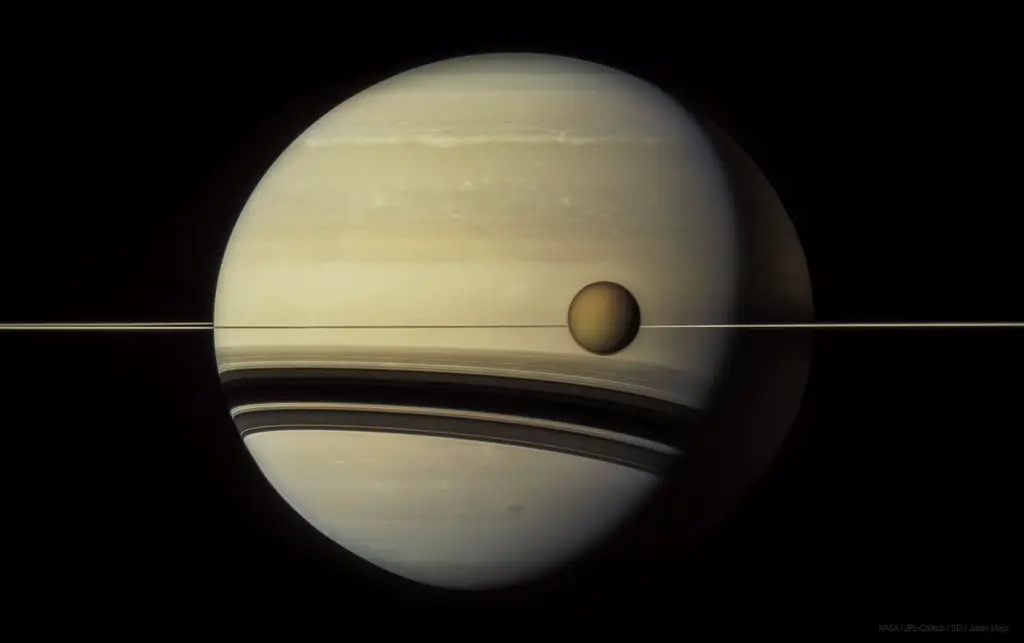Important facts about Titan
Well, 5,150 kilometers is a massive size for a moon and that’s the size of Titan. It is the biggest moon of Saturn and the second biggest in the entire solar system. It is second just to Ganymede (Jupiter’s biggest moon). In fact, it is even bigger than Planet Mercury (which has a diameter of just over 4800km). However, Titan has a lower mass than Mercury and it comprises elements that are low in density.
Temperature
When it comes to the temperature of Titan’s surface, it is around -180 0C. Well, the lowest ever temperature recorded on earth was -89.2 0C (that was recorded in the Australian Antarctic region). So, that gives you an idea about how cold it is on the surface of Titan.
Because of this extremely low temperature, you will find water in its solid form (ice) on Titan. Apart from that, Titan may have sand that is build up with fine crumbs and bits of ice.
Positioning
As you may already know, the Earth’s moon is tidally locked. The same positioning is true with Titan as well. That means you can see only one face of Titan if you are on Saturn’s surface.
Titan’s Geography & Atmosphere
Titan has plenty of volcanoes. When it comes to Earth, you can see molten rock propelled out of volcanoes from the core of the planet. However, volcanoes on Titan send hot water (liquefied ice) along with many other minerals and toxic chemicals including Ammonia.
Interestingly, both the Earth and Titan are considered to be the only objects in our Solar system that sprays out the liquid. On Titan, you can find liquid methene along with some other hydrocarbons as well.
Titan has diversified weather and there are rains in it. However, unlike in the Earth, it rains liquid methane in Titan. Also, on the surface of Titan, there is snow made out of hydrocarbons.
Even though Titan is a moon, it has an atmosphere. Just like in Earth’s atmosphere, Nitrogen is the main gas on Titan’s. However, in Titan, the temperature is too low, and therefore, you cannot find any water vapor in its atmosphere. But there’s plenty of methane vapor in Titan’s atmosphere.
In addition to Nitrogen, the atmosphere of Titan comprises Hydrogen Cyanide, Ammonia, and Carbon Dioxide. The surface of the Titan has a pressure of about 1.5 times that of the sea level of the Earth.
The Earth and Titan comprise clouds. Those clouds reflect a part of the rays of the Sun. That often cools the surfaces of the planets. But the same clouds end up creating a greenhouse effect as well and that is applicable to both plants.
A comparison between Titan and the Earth
There is no shortage of similarities between the Earth and Titan. On the other hand, there are significant differences between these two. One of the most notable differences between the two is temperature. Also, the composition of the atmosphere between the Earth and Titan is so different. Even with those differences, however, it is too early to say that Titan is a lifeless moon!
Earth and Titan are the only known places in the universe where stable bodies of liquid exist on the surface. However, when you look closer at these two giants, there are many differences between them in terms of size, density, and atmospheric composition. Titan is smaller than Earth, but its atmosphere makes up almost 50% of its total mass compared to Earth’s 0.0003%. Additionally, Earth has an average surface temperature of 59 degrees Fahrenheit while Titan has an average surface temperature of -297 degrees Fahrenheit; that’s almost 400 times colder!
![]()
